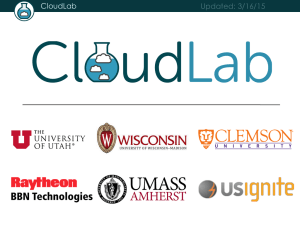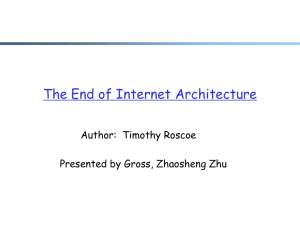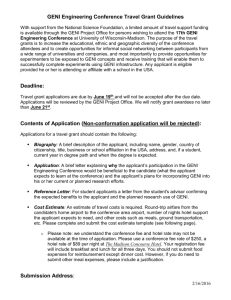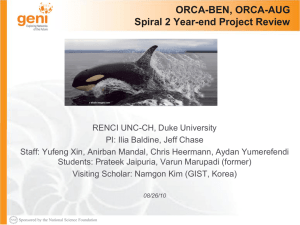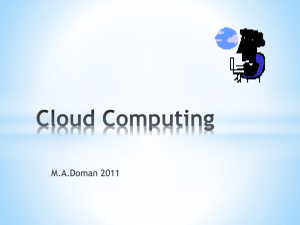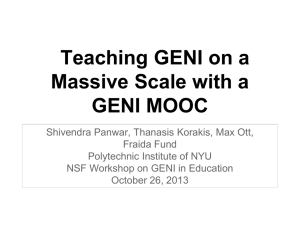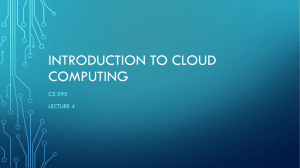Document
advertisement
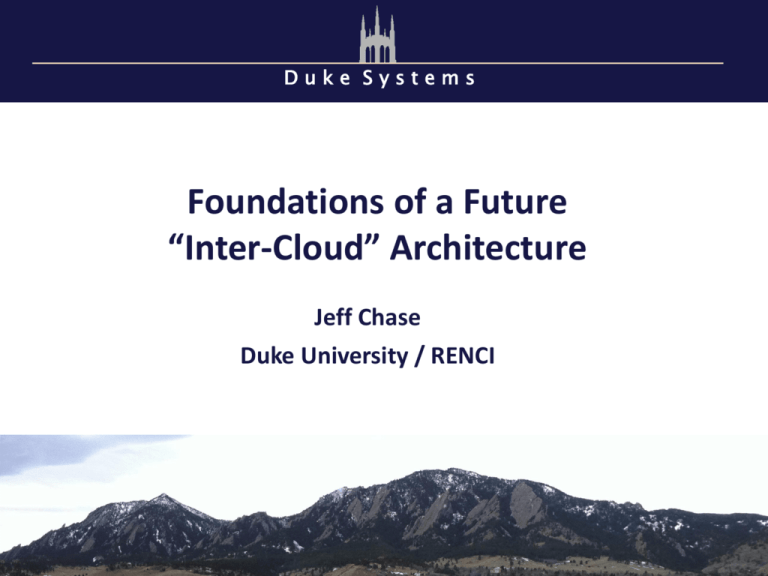
Duke Systems Foundations of a Future “Inter-Cloud” Architecture Jeff Chase Duke University / RENCI Some challenges • Cloud infrastructure resources – diversity and representation • Programmability and isolation – working at the bottom of the stack – configurations and compatibility • Architecture: elements and combinations – assembling virtual infrastructure – orchestrating multi-domain services • Trust Infrastructure as a Service (IaaS) “Consumers of IaaS have access to virtual computers, network-accessible storage, network infrastructure components, and other fundamental computing resources…and are billed according to the amount or duration of the resources consumed.” The GENI Vision A suite of infrastructure for long-running, realistic experiments in Network Science and Engineering Virtualized Deeply programmable Federated substrate with end-to-end virtualized “slices” Sensor Network Federated International Infrastructure “aggregates” Mobile Wireless Network Edge Site Heterogeneous, and evolving over time via spiral development 4 2007 GENI resource model . . . running on researcherspecified network topology Researcher software . . . Virtual topology node pipe Slice dataplane Slice Virtual resource control Slivers (e.g., VMs) Aggregate node Physical pipe Substrate GENI is IaaS • GENI is diverse Infrastructure-as-a-Service • Every IaaS; all connected. Can we build a common resource/sliver abstraction spanning “all” resource types? GENI is IaaS • GENI is diverse Infrastructure-as-a-Service • Every IaaS; all connected. • How much platform? Infrastructure Resources and “Slivers” EC2: The Canonical IaaS Cloud Adding storage Computer CPU Memory Disk BW memory shares Adaptations: Describing IaaS Services 16 → rc=(4,4) → rb=(4,8) → ra=(8,4) b a CPU shares c Adaptations: service classes • Must adaptations promise performance isolation? • There is a wide range of possible service classes…to the extent that we can reason about them. Continuum of service classes Available surplus Weak effort Best effort Reflects load factor or overbooking degree Proportional Elastic share reservation Hard reservation Reflects priority Adaptations: multi-layer networks Network Functional Diagram 1GE Link Connection: 1 GB NDL semantic description: a snippet <!--Polatis-Renci:f1--> <ndl:Interface rdf:about="#Polatis-Renci:f1"> <rdf:type rdf:resource="http://…/ndl/wdm#FiberNetworkElement"/> 10 GE Link Connection: 10 GB <rdfs:label>Polatis-Renci:f1</rdfs:label> <ndl:connectedTo rdf:resource="#Polatis-Duke:f1"/> </ndl:Interface> λ Link Connection: 1 λ (DTF) = 10 GB OCG Link Connection: 1 OCG = 10 λ = 100 GB Breakable Experimental Network Fiber Link Connection: 4 OCG = 40 λ = 400 GB Making connections program program node “switch” node link interface node Resource functions and attributes Programming platform and compatibility.... node SwitchMatrix/CrossConnect capabilities: e.g., tag swapping. router program or....? node Interface capabilities, e.g., VLAN attach/enable. An adaptation VM instance virtual interface logical pipe Building network topologies Cloud hosts with network control Computed embedding Virtual network exchange Virtual colo campus net to circuit fabric IaaS: clouds and network virtualization Virtual Compute and Storage Infrastructure Cloud APIs (Amazon EC2 ..) Virtual Network Infrastructure Network Provisioning APIs (NLR Sherpa, DOE OSCARS, I2 ION, OGF NSI …) Breakable Experimental Network Cloud Providers Transport Network Providers “The missing link” Virtual Infrastructure Bandwidth Provisioned Circuit Network Fabrics Cloud Providers Network Transit Providers Orchestration Keeping it together Flukes Semantic GUI Ilia Baldine Open Resource Control Architecture • ORCA is a “wrapper” for off-the-shelf cloud and circuit nets etc., enabling federated orchestration: + Resource brokering coordinator + VM image distribution + Topology embedding B + Stitching + Authorization • GENI, DOE, NSF SDCI+TC SM • http://networkedclouds.org • http://geni-orca.renci.org controller AM aggregate Overview (1) 1. Create a manager Slice for automated elastic Feedback Manager control and control monitoring of “slice”. Guest-programmable Pluggable controller policies Deployment and monitoring Overview (2) AM 2. Place a new orchestration server (Aggregate Manager or authority) at each provider. AM SM 3. Empower AM to approve remote requests according to local policies, and invoke local control interfaces as needed. Inside an aggregate generic front-end Testbed user requests AM plugins AM image/cert proxy, FlowVisor, etc. Aux Site Service Resource handler Other user requests IaaS API Infrastructure Service (e.g., cloud stack or transport network service) Overview (3) AM 4. Add brokering services for federation, resource discovery, coordination. AM SM Brokering Services 5. Advertise or delegate resources to broker. Overview (4) AM 6. Automate distribution of images, and endorsement of their attributes. AM SM Image/Appliance Services NDL-OWL: Making the most of semantic resource descriptions Resource request G-API Users and tools B SM Reservation lease Sliver reservation manifest Substrate abstraction and advertisement AM Full substrate description NDL-OWL • NDL-OWL ontology (Semantic Web) extends Network Description Language (NDL), based on G.805 model. – uva.nl SNE: http://www.science.uva.nl/research/sne/ndl – NDL represents substrate: topology, connectivity, layers, adaptations (e.g., circuits, virtualization) – NDL enables path computation by SPARQL queries • NDL-OWL adds abstracted views of resources – Abstracted view of substrate (resource advertisements) – Resource requests, embeddings, and allocation – Edge resources and their configuration – Label sets (e.g., VLAN tags), label produce/consume tags NDL-OWL in ORCA • Represent resource semantics for IaaS systems declaratively. – Not “baked in” to control framework. – Drive control framework actions by queries on models. • NDL-OWL adds semantically rich labels for dynamic provisioning. – Capacity constraints, QoS, usage tracking • NDL-OWL modules in AMs drive templated configuration commands automatically. – setup/teardown handler calls from Aggregate Manager • NDL-OWL modules in SM generate dependency graph for sequenced stitching. – Declarative stitching framework: propagate typed labels from producers to consumers along dependency DAG NDL-OWL Logic B RSpecNDL-OWL conversions G-API Users and tools Resource query matching, bandwidth/endpoint allocation NDL-OWL representations drive stitching by label propagation along dependency DAG. SM Interdomain topology embedding and stitching dependency DAG inference lease AM Resource allocation and stitching ExoGENI • Every Infrastructure as a Service, All Connected. – Substrate may be volunteered or rented. – E.g., public or private clouds and transit providers • ExoGENI Principles: – Open substrate – Off-the-shelf back-ends – Provider autonomy – Federated coordination – Dynamic contracts – Resource visibility Breakable Experimental Network Applications and Platforms AM AM NDL-OWL semantic web representations for substrate and requests. SM GENI-API and ALT-G NDL User tools request topologies for experiments, systems, applications. Topology requests specified in NDL NDL-OWL drives embedding and stitching by label propagation along dependency DAG. SC11 Demo: Solar Fuels Workflow argos.x mcdrt.x mcscf.x mcuft.x mofmt.x tran.x PSOCI.x Serial (Condor/Orca) MPI (Hopper) Image provided by UNC-CH EFRC: http://www.efrc.unc.edu/ Oxidation catalysts Example Dynamic Workflow: Ensemble • Wide step of Ensemble is temporal • Width may not be known before ensemble generation Ensemble Generator Create slice of resources Provisioning for ensemble step Collector Delete slice of resources for De-provisioning ensemble step 38 Trust Federated trust challenges • External identity providers (SAML SSO) – Assertion of identity attributes • Trust structures for federated coordination – Multiple overlapping federations/policies • Declarative trust structure and policy – Delegation, inference, audits, accountability – Global slices with capability-based protection – Software-defined networking services and rights – Image certifications/endorsements – stitching GENI trust structure: overview (v1.0) Users and tools GENI Operations and Control CH Users create global slices and request aggregates to bind local resources to those slices. Bidirectional trust based on agreements AM AM AM AM Principals are users and organizations, and tools or servers acting on their behalf. GENI trust structure (v2.0) GENI “Clearinghouse” GOC GMOC IdP AM PA AMs trust the coordinators, transitively. I&M SA AM NSF GENI Federation provides identity and authorization services (coordinators) for GENI aggregates. Example: Identity Provider (IdP) IdP Register user user registered T D Issue user credentials • An IdP asserts facts about users. • User attributes may include inCommon attributes harvested through indirect delegation to Shibboleth IdPs. • These attributes may have parameters with simple values (strings or numbers). IdP.geniUserT IdP.studentT IdP.enrolled(CS-114)T IdP.geniUserD IdP.facultyD Users have roles e.g., student, faculty. GENI Authorization: Workflow Cloud-Based Credential Store Issue project x credentials Issue user credentials IdP 1 Register user Issue slice s credentials PA 2 SA Create project 3 Delegate 4 Create slice in x 5 Create sliver in s The view from an AM AM • To an aggregate, the world is (has) a cloud of coordinators that the aggregate may accept, or not. • Think about EC2: it only cares about VISA and MasterCard. The view from an AM AM • A federation is just a convenient grouping of coordinators for an AM to accept as a bundle. • An AM may even accept them without “joining” the Federation, i.e., agreeing to conform to its dictates. AM-centric view of coordination Any surrender of sovereignty to a Federation is voluntary, or induced by sociopolitical factors outside the trust structure. AM The NSF GENI AMs choose to surrender. AM-centric view of coordination AM Therefore, we should design coordinators that leave AMs free to choose from the menu of coordinators available. To the extent that AMs choose the same coordinators, they should work. Software Service as a Subject • Trust is “typically” based on a human or organizational identity. • Can we trust a service or program instance independent of our trust in its owner (SP)? • Can a slice or cloud-hosted service be “its own” subject? • Add new building blocks: – Assert/certify program attributes – Remote attestation “Trusted Platform Cloud” • Trusted entity certifies program properties. • AM attests to loaded program or image • Client infers instance attributes from program properties • Sealed instances Service Instance Identity (SID): autonomous, independent of owner. Signed, Sealed, Delivered • Program (or image) must be signed and endorsed by entity trusted by clients. • Program is delivered to the cloud sites where it runs, under control of SP (instance owner). • Cloud provider (AM) seals the instance to prevent post-launch tampering by SP. – Administer through well-defined interfaces only. – No “log in as root” – Cloud provider issues fresh key and attestation. Example: Trusted Platform as a Service A Service Provider requests a new instance to run a Python/Django program. ORCA launches a trusted image designated for running secured code. The image has a script that fetches the program, launches it, and seals itself. Andrew Brown et. JC, Trusted Platform-as-a-Service: A Foundation for Trustworthy Cloud-Hosted Applications, CCSW 2011 Toward an “InterCloud” and FIA • Networked clouds present a range of challenges – Identity, trust, governance, policy – Resource representation and resource control • An “InterCloud” must provide some some coordination services trusted by aggregates. • The trust graphs must match the inter-cloud governance/agreement structure, which may be complex and fluid. – Specify them declaratively with a trust delegation logic. – Evolve them according to events at the socio-political layer. • Attestation of hosted services enables a trustworthy ecosystem of cloud application. • Next: pricing, economics, and adaptation

